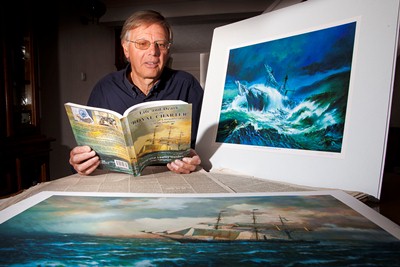
Never-before-seen underwater video footage of Wales’ greatest shipwreck is going to be premiered next month.
The steam clipper Royal Charter was smashed against rocks off Moelfre, Anglesey, by the storm of the century, a Force 12 hurricane, with the loss of least 459 passengers and crew on October 26, 1859.
The ship was returning from Melbourne on its way to Liverpool and laden with gold from the Australian gold fields.
The film will be shown by diver Chris Holden, treasurer of the Chester Branch of the British Sub-Aqua Club (BSAC).
Chris and his wife, Lesley, wrote of one of the definitive works on the tragedy – Life and Death on The Royal Charter.
He will show the video as part of a lecture on the Royal Charter at the Chester Grosvenor Museum on October 25, on the eve of the 152nd anniversary of the maritime tragedy.
Mary Tetley, Chief Executive of the British Sub-Aqua Club, said: “Chris and Lesley have done a phenomenal job in researching the story of the Royal Charter and the lecture will give us a new and fascinating insight into this maritime catastrophe.”
Along with unseen footage, it will be the first opportunity for many to see artefacts from the wreck, which include a small model of the vessel’s newly invented lifting propeller system, recovered from the wreck site less than 12 months ago.
The 2,719 ton steel-hulled clipper employed auxiliary engines when there was no wind, and the new propeller system lifted out the water when she was under sail to prevent drag in the water.
Chris, of Higher Kinnerton, Flintshire, who has dived the wreck since 1982, will also have at his talk Raymond Agius, a direct descendant of the heroic crewman Joseph Rogers (Maltese born Guze Ruggier), who, incredibly, managed to swim ashore with a rope helping to save lives. Twenty-one passengers and 18 crew survived. The scene was visited and described by the great novelist Charles Dickens.
Retired computer engineer Chris, who has been a BSAC member since 1971 and in the Chester branch since 1976, and wife Lesley, decided to write their book for the 150th anniversary of the disaster, despite the fact that an account had already been published many years before by Alexander McKee.
“I wanted to put forward a different point of view and cover a broader area, using a lot of the original news reports of the time and include details of other voyages by The Royal Charter, not covered in the McKee book.
“We used reports from the Caernarfon and Denbigh Herald, Times, and North Wales Chronicle, among others.
“Since the book I have been contacted by a number of relatives of those who died. Two or three weeks ago I had an inquiry from a lady in Australia, all she knew was that her great,great-grandfather had cut his two sons out of his will, for whatever reason, and then died in the disaster.
“I’ve also kept in touch with Raymond Agius, descendant of Joseph Rogers and he has taken a copy of our book to present to the library in Malta,” said Chris.
The Royal Charter carried 79,000 ounces of gold bullion which was insured for £322,000 although much more gold must have been on board, most of it carried by the miners who had struck it rich and were on their way home.
Some gold coins are rumoured to still wash up in Anglesey but Chris says in nearly 30 years of diving the wreck he has never found any! All that remains of the wreck now are bulkheads and plates which are covered and uncovered by shifting sands.
Celebrity gardener Monty Don recently discovered on TV’s Who Do You Think You Are? that his great, great grandfather, the Rev Charles Vere Hodge, perished in the disaster.
For superstitious mariners, the Royal Charter seemed dogged by misfortune. It was built in Sandycroft but the original owners went bankrupt. Chris believes the hull was made on the banks of the River Dee in Flintshire but the steam engines were fitted in Liverpool.
It even got stuck when it was launched and was almost wrecked when grounded before it got to Liverpool.
Anyone interested in attending the lecture, which starts 7.30pm at the museum on October 25 and which will raise funds for the Chester branch of BSAC, can buy a £5 ticket from Chris at 33 Meadowcroft, Higher Kinnerton, near Chester, CH4 9AY.
Ticket details and more on Life and Death on The Royal Charter, by Chris and Lesley Holden, and of two volumes about diving in North Wales, written by Chris, are also available at www.calgopublications.co.uk and to contact BSAC to find out about diving in your area, go to www.bsac.com or call free on 0500 947 202.
About the British Sub Aqua Club (BSAC):
BSAC trains and represents 35,000 active scuba divers and snorkellers. It is the UK National Governing Body and official voice of scuba and snorkelling, working with organisations like the Health and Safety Executive, the RNLI, Marine Coastguard Association (MCA), Marine Conservation Society, HM Treasury’s Receiver of Wrecks, DEFRA and other diving organisations.
BSAC is the world’s largest diving club and has 1,000+ sociable, family-based local branches and more than 120 diving centres spread across the country and worldwide. From beginner to expert, BSAC provides extensive diver training and the resources and back-up divers need to keep skills sharp and to help them enjoy diving safely. It welcomes membership of divers trained by all other agencies.